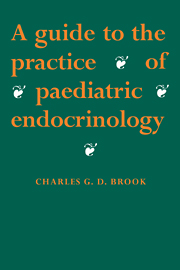3 - Puberty
Published online by Cambridge University Press: 09 October 2009
Summary
Normal puberty and its endocrine control
The hypothalamo-pituitary-gonadal axis (Fig. 3.1) is functional in the fetus, and the effects of its lack can be seen in inadequate male development. Shortly after birth, concentrations of sex steroids and gonadotrophins are in the adult range, and they gradually reduce over the early months of life. They are easily stimulable at this age.
It seems clear that there is both positive and negative feedback in the system so that maternal hormones prime the axis and their withdrawal at birth spurs it into endogenous activity. During the childhood years, pulsatile GnRH secretion reduces, but the system is not as inactive as it was once thought to be. Measurement of 24 h hormonal profiles reveals that young children have occasional bursts of nocturnal gonadotrophin secretion, which increase in frequency and amplitude as the years go by, long before the signs of secondary sexual characteristics appear (Fig. 3.2). It is presumed that these changes arise secondarily to maturation of the GnRH pulse generator.
Activity can also be observed in ovarian morphology and in uterine size seen in ultrasonographic pelvic examination of girls during the childhood and pubertal years (Fig. 3.3). The prepubertal ovary is a small ovoid structure with a few small follicles; as soon as nocturnal pulsatile gonadotrophin secretion becomes established, the morphology becomes multicystic. 24 h gonadotrophin secretion allows the development of a dominant follicle which will ovulate when an LH surge is generated.
- Type
- Chapter
- Information
- A Guide to the Practice of Paediatric Endocrinology , pp. 55 - 82Publisher: Cambridge University PressPrint publication year: 1993



